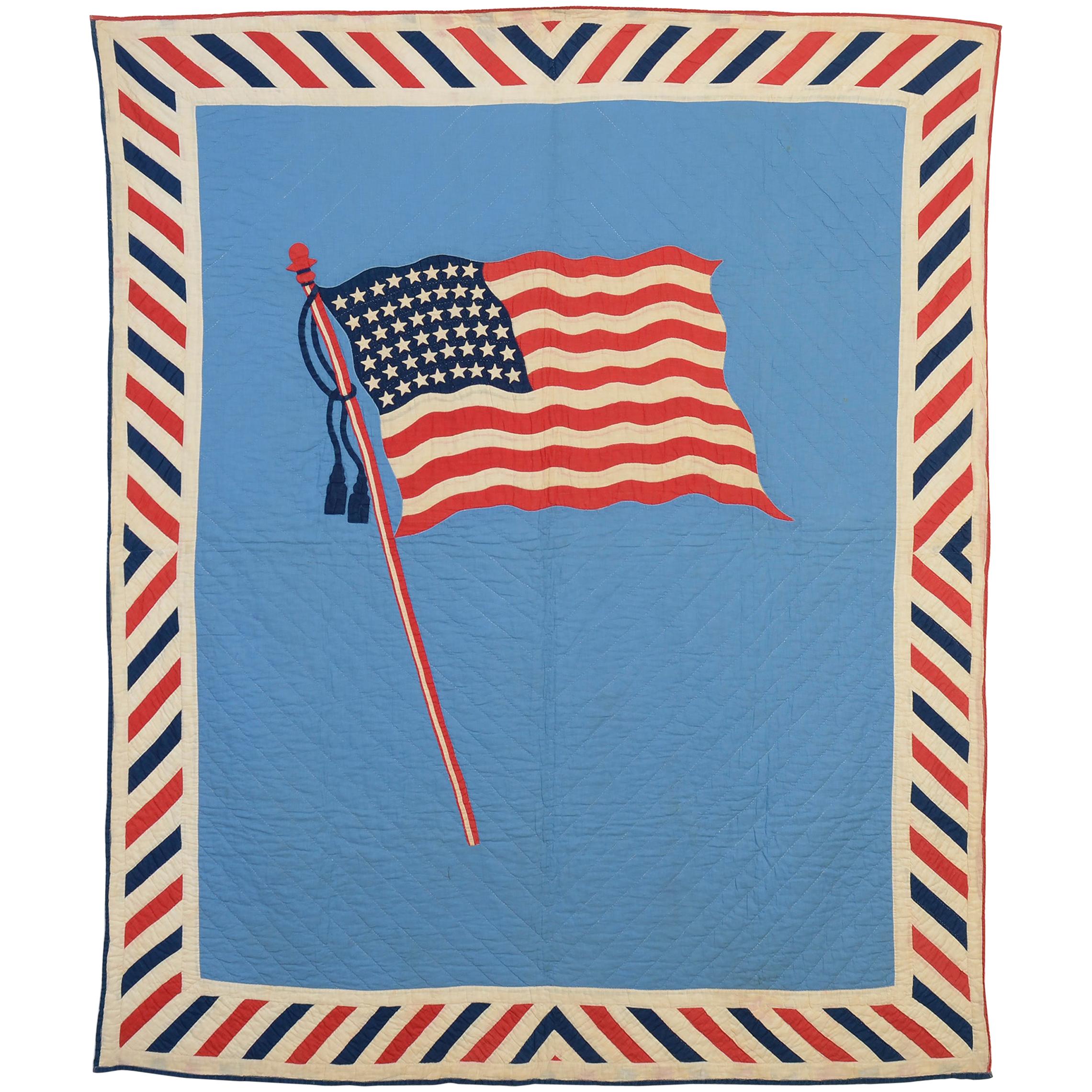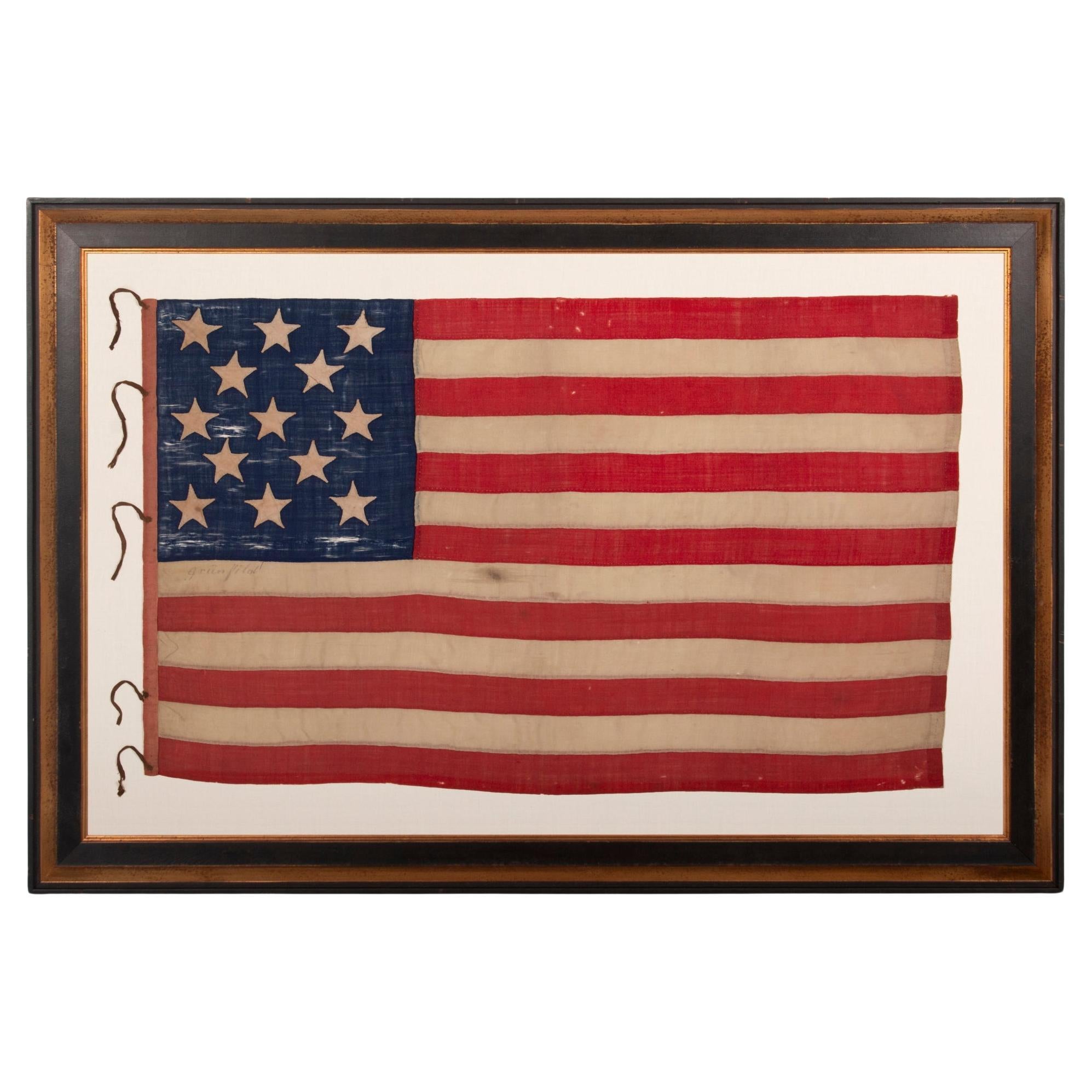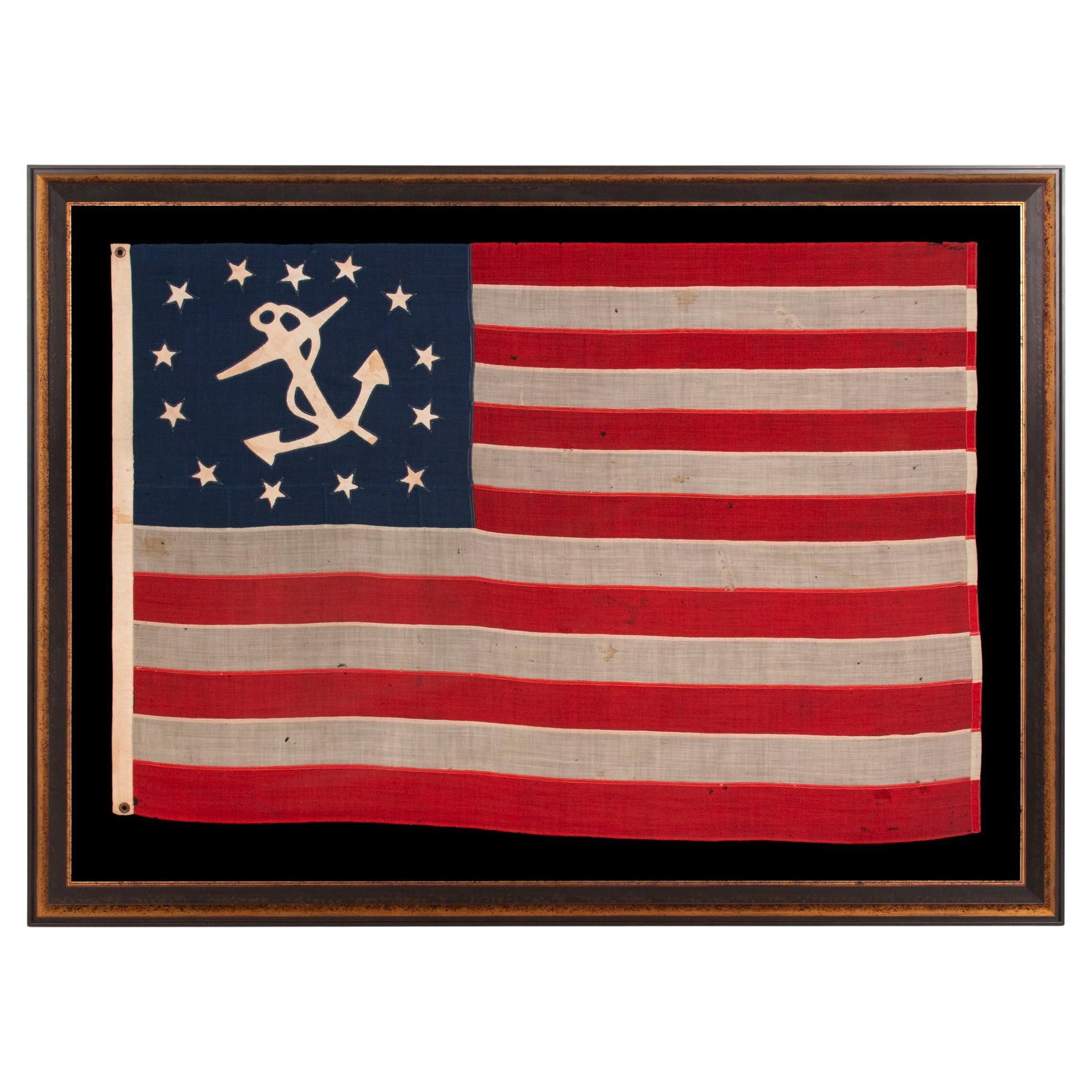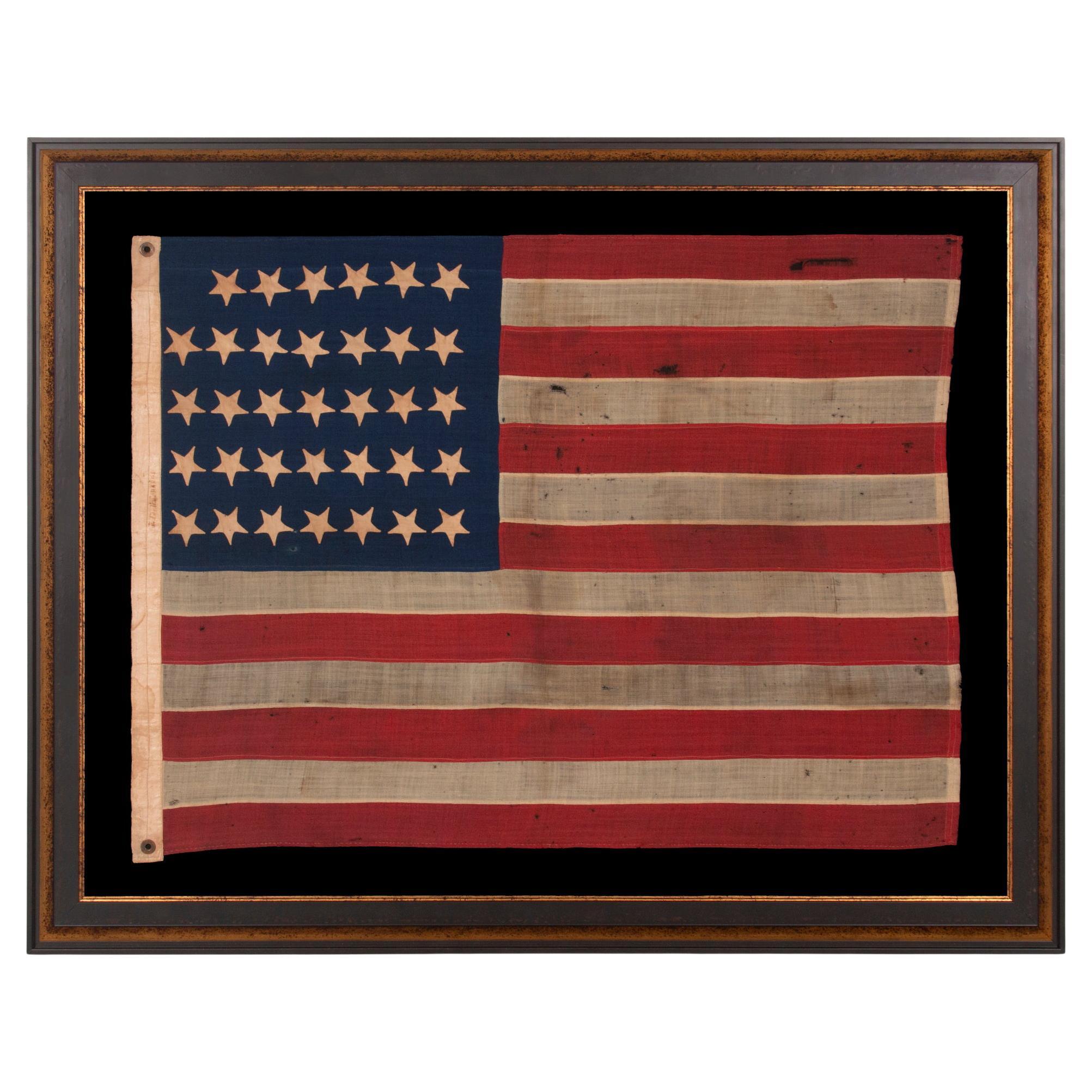Items Similar to Framed Hand Sewn Patriotic Sham Made from a Flag and Ship Ribbons
Want more images or videos?
Request additional images or videos from the seller
1 of 7
Framed Hand Sewn Patriotic Sham Made from a Flag and Ship Ribbons
About the Item
This Great framed Folk Art sham with 48star flag and ship ribbons is a great patriotic item. The top left corner as well as the bottom right corner are scraps of a 48 star linen flag and in between them are ribbons of ships names that are sewn together in a collage. The American ships span three centuries of ships ribbons, from late 19th century to present day ships. As well as the "USS Utah" which was sunk during the attack on Pearl Harbor.
This great and proud sham is not only a great American item but is a Symbol of hope and unity throughout the ages. Serves better as a hanging Folk Art than a pillow case sham. The frame is a linen backing within a custom plexiglass frame.
- Dimensions:Height: 22 in (55.88 cm)Width: 22 in (55.88 cm)Depth: 1.75 in (4.45 cm)
- Style:Folk Art (In the Style Of)
- Materials and Techniques:Plexiglass
- Place of Origin:
- Period:
- Date of Manufacture:1930s
- Condition:Wear consistent with age and use. Pillow Sham made into a hanging folk art item.
- Seller Location:Los Angeles, CA
- Reference Number:
About the Seller
4.9
Platinum Seller
These expertly vetted sellers are 1stDibs' most experienced sellers and are rated highest by our customers.
Established in 1985
1stDibs seller since 2004
1,602 sales on 1stDibs
Typical response time: <1 hour
- ShippingRetrieving quote...Ships From: Los Angeles, CA
- Return PolicyA return for this item may be initiated within 3 days of delivery.
More From This SellerView All
- Patriotic Folky Uncle Sam, Garden OrnamentLocated in Los Angeles, CAHandmade and painted Uncle Sam in all original painted surface.Category
20th Century American Country Political and Patriotic Memorabilia
MaterialsPaint, Wood
- Early 20thc 48 Star Flag Hand Crochet PillowLocated in Los Angeles, CAThis fine hand crochet 48 star flag pillow is made with a blue velvet background or frame front and back.The insert is down & feather fill.Category
Early 20th Century American Adirondack Pillows and Throws
MaterialsWool
- Original Painted Metal Parade FlagLocated in Los Angeles, CAThis fun and folky 20thc original painted parade flag sign was used to hand in the windows during patriotic events. In stores and homes in the early 20thc.Category
Antique Late 19th Century American Adirondack Political and Patriotic Me...
MaterialsTin
- Large 48 Star Embroidered Flag PillowBy American Flag & Banner Co.Located in Los Angeles, CAThis monumental 48 star flag pillow is in great in great condition and has a red cotton linen pillow. The big pillow id down and feather fill.Category
Mid-20th Century American Country Political and Patriotic Memorabilia
MaterialsCotton
- Patriotic Hand Painted Slate FrameLocated in Los Angeles, CAThis amazing Folk Art hand made & painted slate frame was found in Pennsylvania. Has a wonderful undisturbed painted surface.Category
Vintage 1920s American Adirondack More Folk Art
MaterialsSlate
- Bronze Eagle Bookends Signed and Dated, 1931By Eagle & YoungLocated in Los Angeles, CAThis is an amazing and heavy bronze bookends signed and dated Eagle & Young, 1931. These bookends are in very good condition.Category
Vintage 1930s American American Classical Political and Patriotic Memora...
MaterialsBronze
You May Also Like
- Patriotic Flag Quilt Old GloryLocated in Darnestown, MDNothing could be more of the moment than this patriotic flag quilt depicting Old Glory. It was most likely made either for the admission of Arizona into st...Category
Early 20th Century American Folk Art Quilts
MaterialsCotton
- Hand-Sewn 13 Star American Flag, Signed Grunfild, ca 1861-1877Located in York County, PAENTIRELY HAND-SEWN ANTIQUE AMERICAN FLAG OF THE CIVIL WAR ERA, WITH 13 SINGLE-APPLIQUÉD STARS IN A 3-2-3-2-3 CONFIGURATION, IN A GREAT, SMALL SCALE AMONG ITS COUNTERPARTS, PROBABLY MADE IN NEW YORK CITY, SIGNED “GRÜNFILD” 13 star flags have been flown throughout our nation’s history for a variety of purposes. They were hoisted at patriotic events, including Lafayette’s final visit in 1824-25, the celebration of the centennial of American independence in 1876, and the sesquicentennial in 1926. They were displayed during the Civil War, to reference past struggles for American liberty and victory over oppression, and were used by 19th century politicians while campaigning for the same reason. As the number of stars grew with the addition of new states, it became more and more difficult to fit their full complement on a small flag. The stars would, by necessity, have to become smaller, which made it more and more difficult to view them from a distance as individual objects. The fear was that too many of them close together would become as one white mass and distort the ability to identify American ships on the open seas. Keeping the count low allowed for better visibility. For this reason the U.S. Navy flew 13 star flags on small boats. Some private ship owners mirrored this practice and flew 13 star flags during the same period as the Navy. Flag experts disagree about precisely when the Navy began to revert to 13 stars and other low counts. Some feel that the use of 13 star flags never stopped, which seems to be supported by depictions of ships in period artwork. This was, of course, the original number of stars on the first American national flag, by way of the First Flag Act of 1777, and equal to the number of original colonies that became states. Since there was no official star configuration until the 20th century (1912 specifically, beginning with the 48 star count), the stars on 13 star flags may appear in any one of a host of configurations. Made during the Civil War era, or shortly thereafter, the stars of this particular 13 star flag are arranged in a 3-2-3-2-3 pattern of lineal rows. This configuration appears to have been adopted by the Navy sometime toward war’s end, probably between 1864 and 1865. Afterwards it becomes the most common design across all known styles, for the balance of the 19th century through the first quarter of the 20th. Entirely hand-sewn, the stripes and canton of the flag are made of wool bunting. Note in particular the square profile of the canton, which makes it visually different from modern flags. The stars are made of cotton and are single-appliquéd. This means that they were applied to one side of the canton, then the blue fabric was cut from behind each star, folded over, and under-hemmed, so that one star could be viewed on both sides. I always find single-appliquéd stars more interesting, not only because they are evidence of a more difficult level of seam-work and stitching, but also because they are more visually intriguing. The two visible rows of hand-stitching emphasize their hand-sewn construction. This is one reason why single-appliquéd stars appeal to connoisseurs of early American textiles. While some flag enthusiasts have pointed to this as a means of conserving fabric, not having to cut and sew another star to the opposite side, others suggest that the real purpose was to make the flag lighter in weight. I believe it to have been a byproduct of both objectives. A length of faded, red, herringbone, twill cotton tape was stitched along the hoist end for reinforcement, in lieu of a more formal binding. To this, six lengths of cotton knit shoelace were added (one now absent) as a means of affixing the flag to a staff. This is generally the accepted method for a flag that is to be hand-carried. The cloth tape and ties both add substantially to the flag’s visual presentation. The name “Grünfild” was at some point hand-inscribed beneath the canton. It was common to mark flags in this fashion, during the 19th and early 20th centuries, to indicate ownership. An unusual name in America at this time, I believe that this likely belonged to the only man by this name that is recording as having served during the Civil War. Born around 1843, Morris Grünfild [a.k.a. Grünfield / Greenfield / Grünfildt] emigrated to the United States from Eastern Europe in 1854. A merchant tailor, who I believe may have been of Russian Jewish descent, he records himself as having been born in “Poland / Rus,” but may have moved to Austria in the interim, before traveling to the States. In May of 1861, Grünfild enlisted with the 31st New York Volunteer Infantry, at the rank of Private, in New York City, and was assigned to “C” Company. He served two years, mustering out in New York on June 4th, 1863. Around 1877, Grünfild joined Frank Head Post #16 of the New York State Grand Army of the Republic. The GAR was the primary veteran’s organization for the Union Army. He married a Russian woman from Philadelphia, had many children, and continued to work as a tailor into the 20th century, possibly selling both his services and clothes. Presuming that it was this Morris Grünfild who owned and marked the flag, it is hard to be sure just how he came into possession of it. The construction is actually typical of flags produced in New York, during this time frame and after, by the Annin Company. Known for single-appliqued stars, and for hand-sewing the stripes of smaller flags in particular, as well as for simply producing more, small, sewn flags than their competitors, the flag closely approximates signed, Annin-made examples that I have previously owned. It may, of course, be that Grünfild acquired the necessary bunting at the wharf and sewed the flag in the same fashion as Annin, but I don’t think so. I do, however, believe that it was he who added the herringbone tape and shoelace ties to a flag probably of Annin manufacture. It’s possible that the 31st NY Regiment used the flag as a flank marker or as camp colors. Though a little large in scale for either when compared to military regulations, the flag is small enough to have served effectively in either function. This unit appears not to have turned any colors in to the state at the war’s end, so likely they were taken home. The role that Grünfild played as a private in C Company is unknown. As a tailor, it’s conceivable that he may have played a role in the care or upkeep of flags, but no further information is available. The 31st NY was a very active unit. Recruited from Williamsburg (just over the Brooklyn Bridge) and Manhattan, it had several nicknames, including the “Montezuma Regiment,” “Baxter Light...Category
Antique Late 19th Century American Political and Patriotic Memorabilia
MaterialsCotton
- Outstanding 13 Star Hand-sewn American Private Yacht Flag, ca 1865-1885Located in York County, PAOUTSTANDING, 13 STAR, ANTIQUE AMERICAN PRIVATE YACHT ENSIGN WITH GREAT FOLK QUALITIES THAT INCLUDE AN UNUSUALLY WIDE ANCHOR AND A DECIDEDLY LOPSIDED RING OF 13 STARS; MADE DURING THE 2ND HALF OF THE 19TH CENTURY; ITS DEVICE HAND-SEWN AND SINGLE-APPLIQUÉD Private yacht ensigns were approved American signals for maritime use that allowed pleasure boats to bypass customs. Though the legislation that approved them was adopted prior to 1850, almost all such flags that one will encounter were sewn by electric machine and made during the 20th century. The unusual gems among surviving examples are those that are earlier and include hand-sewn elements. Even more rare are a select few with atypical graphics. Barely any fall into both of these categories at once. Take note of the anchor on this particular flag, wide a long horizontal crossbar (stock) that contributes to uncommonly wide stance. Set within a ring of stars that is decidedly lopsided, the result is as bold as it is endearingly whimsical—two of the best qualities in American folk art, a category in which this particular example can be filed. While I have owned 13 star private yacht flags that have displayed star and canted anchor devices that were somewhat larger and/or bolder than typical, I cannot recall any that were so graphically intriguing as this one. Brief History of Private Yacht Ensigns: The medallion configuration, 13-star, 13-stripe flag, with a canted center anchor was entered into official use in 1848, following an act of Congress, that made it the official signal for U.S. pleasure sailing vessels. The need for such a flag arose with the popularity of boating as a pastime for well-to-do Americans, and as a competitive sport, in addition to its longstanding utilitarian role as a vehicle of trade. In early America, all boats were subject to customs searches at every port. Without modern income tax, the federal government derived its revenues mostly from tariffs, so an accounting of foreign goods on ships was a critical venture. As yachting for pleasure became more prevalent, however, more and more time was spent searching boats that had no such inventory, wasting time for both customs officials and wealthy ship owners. John Cox Stevens, a former president of the Jockey Club and future founder of the Union League Club, became the New York Yacht Club’s Commodore upon its founding in 1845. In 1847 he approached the secretary of the treasury and suggested that something be done to streamline the customs process for non-trade vessels. In 1848, legislation passed Congress requiring registration of these boats, which could then fly the “American Yachting Signal” to bypass customs. This remained on the books until the 1980’s, when the 1848 legislation was revoked, but the use of flags in this design for decorative function continues to this day. 13 star flags have been flown throughout our nation’s history for a variety of purposes. In addition to their use on private yachts, they were hoisted at patriotic events, including Lafayette’s final visit in 1824-25, the celebration of the nation’s centennial in 1876, and the sesquicentennial in 1926. They were displayed during the Civil War, to reference past struggles for American liberty and victory over oppression, and were used by 19th century politicians while campaigning for the same reason. The U.S. Navy used the 13 star count on small boats until 1916, because it was easier to discern fewer stars at a distance on a small flag. Commercial flag-makers mirrored this practice and some private ships flew 13 star flags during the same period as the Navy. Construction: The stars and anchor are made of cotton, hand-sewn, and single-appliquéd. This means that they were applied to one side of the canton, then the blue fabric was cut from behind each star, folded over, and under-hemmed, so that one star could be viewed on both sides of the flag. I always find single-appliquéd stars more interesting, not only because they are evidence of a more difficult level of seam-work and stitching, but also because they are more visually intriguing. The two visible rows of hand-stitching emphasize their hand-sewn construction. For these reasons, single-appliquéd stars often appeal to connoisseurs of early American textiles...Category
Antique Mid-19th Century American Political and Patriotic Memorabilia
MaterialsWool
- 13 Star American Flag with Hand-Sewn Stars in the 3rd Maryland PatternLocated in York County, PA13 hand sewn stars in a circular version of what is known as the 3rd Maryland pattern, with an especially large center star, a flag with especially tiny scale among those with pieced-and-sewn construction, exceptionally rare, made circa 1890: 13 star flags have been flown throughout our nation’s history for a variety of purposes. They were hoisted at patriotic events, including Lafayette’s visit in 1824-25, the celebration of the centennial of American independence in 1876, and the sesquicentennial in 1926. They were displayed during the Civil War, to reference past struggles for American liberty and victory over oppression, and were used by 19th century politicians while campaigning for the same reason. As the number of stars grew with the addition of new states, it became more and more difficult to fit their full complement on a small flag. The stars would, by necessity, have to become smaller, which made it more and more difficult to view them from a distance as individual objects. The fear was that too many of them close together would become as one white mass and distort the ability to identify American ships on the open seas. Keeping the count low allowed for better visibility. For this reason the U.S. Navy flew 13 star flags on small boats. Some private ship owners mirrored this practice and flew 13 star flags during the same period as the Navy. Flag experts disagree about the precisely when the Navy began to revert to 13 stars and other low counts. Some feel that the use of 13 star flags never stopped, which seems to be supported by depictions of ships in period artwork. This was, of course, the original number of stars on the first American national flag, by way of the First Flag Act of 1777, and equal to the number of original colonies that became states. Any American flag that has previously been official remains so according to the flag acts, so it remains perfectly acceptable to fly 13 star flags today by way of congressional law. Since there was no official star configuration until the 20th century (1912 specifically, beginning with the 48 star count), the stars on 13 star flags may appear in any one of a host of configurations. Some of these are more rare and desirable than others. The stars of this particular flag are arranged in what has come to be known as the "3rd Maryland Pattern." This configuration, whether oval or circular, is appreciated both for its visual appeal and the scarcity of its use. a circular wreath of 12 with a single star in the center. The name comes from a flag that resides at the Maryland State Capitol in Annapolis, long thought to have been present with General Daniel Morgan at the Battle of Cowpens in 1781. According to legend, the flag was supposed to have been carried by Color Sergeant William Batchelor of the 3rd Maryland Light Infantry and was donated to the State of Maryland by Batchelor's descendants. The story was disproved in the 1970's, however, following an examination by the late flag expert Grace Rogers Cooper of the Smithsonian, who discovered that the Cowpens flag was, at the earliest, of Mexican War...Category
Antique 1890s American Political and Patriotic Memorabilia
MaterialsWool
- 34 Star Flag with Upside down Hand Sewn Stars, Kansas Statehood, ca 1861-1863Located in York County, PA34 Upside-down, Hand-sewn Stars In A Notched Configuration, On An Antique American Flag Of The Civil War Period, With A Beautiful And Highly Unusual Jacquard Weave Binding, And In A Tiny Scale Among Its Counterparts, Reflects The Addition Of Kansas As The 34th State, 1861-1863 34 star American national flag with a number of interesting and desirable features. Chief among these is the scale of the flag among counterparts of the period. At just three by four feet, its size is absolutely tiny among those with pieced-and-sewn construction. During the 19th century, sewn flags (as opposed to those that were printed on cloth) were typically eight feet long and larger. This is because they were important in their function as signals, meaning that they needed to be seen and recognized from great distance. A flag that was six feet in length was considered small and production of flags smaller than this was extremely limited. Even infantry battle flags, carried on foot, were approximately six by six and-one-half feet, about the size of an average quilt of the same period. It wasn't until the 1890’s that manufacturers began to produce smaller sewn flags in great quantity. The stars of the flag are arranged in justified lineal rows, the first of which contains one fewer star. This results in what I call a “notched” design, leaving one space open for the addition of another star. The blank space leaves little doubt that the maker of the flag assumed that another Western Territory would soon acquire statehood, or that West Virginia might soon break free from Virginia, which occurred in June of 1863. Note how the stars are oriented so that they are upside-down on their vertical axis, with two points up instead of one. No one knows if this positioning bore any particular meaning. Both modern notions of the correct orientation of a star, and the present official design of the American flag, dictate that the stars are supposed to have one point up. Since there was no official design for the flag until 1912, however, it may simply be that the maker of the flag did not consider any particular position to be right-side-up or upside-down. In the mid-19th century, it was not uncommon to see stars pointing any which way, varied throughout whatever arrangement was chosen. Whatever the case may be, the feature present on this particular flag is unusual to the eye and notable in terms of its presentation. Made of cotton, the stars are hand-sewn and double-appliquéd (applied to both sides). The canton and stripes of the flag are made of wool bunting. Because blue wool bunting generally came in a width of 18", the canton was pieced from two lengths of fabric, joined by hand-stitching. The canton is joined to the striped field by hand-stitching. The stripes are pieced and hemmed by treadle stitching. Made of heavy, polished, jacquard weave linen, the binding of the flag is both exceptional from a textile connoisseur’s perspective and highly unusual. This is joined to the flag by treadle stitching. There are two brass grommets, one each at the top and bottom of the hoist, which are likewise especially unusual, in that they are both heavier than normal and intentionally hammered flat. I have seen this on only one other occasion in a Civil War flag...Category
Antique Late 19th Century American Political and Patriotic Memorabilia
MaterialsWool
- 13 Star Antique American Flag with Hand-Sewn Stars in 5-3-5 Pattern, ca 1861-65Located in York County, PAAntique American flag with 13 hand-sewn stars in an extremely rare lineal configuration of 5-3-5, probably made with the intent of use by local militia or private outfitting of a vol...Category
Antique 1860s American Political and Patriotic Memorabilia
MaterialsWool





